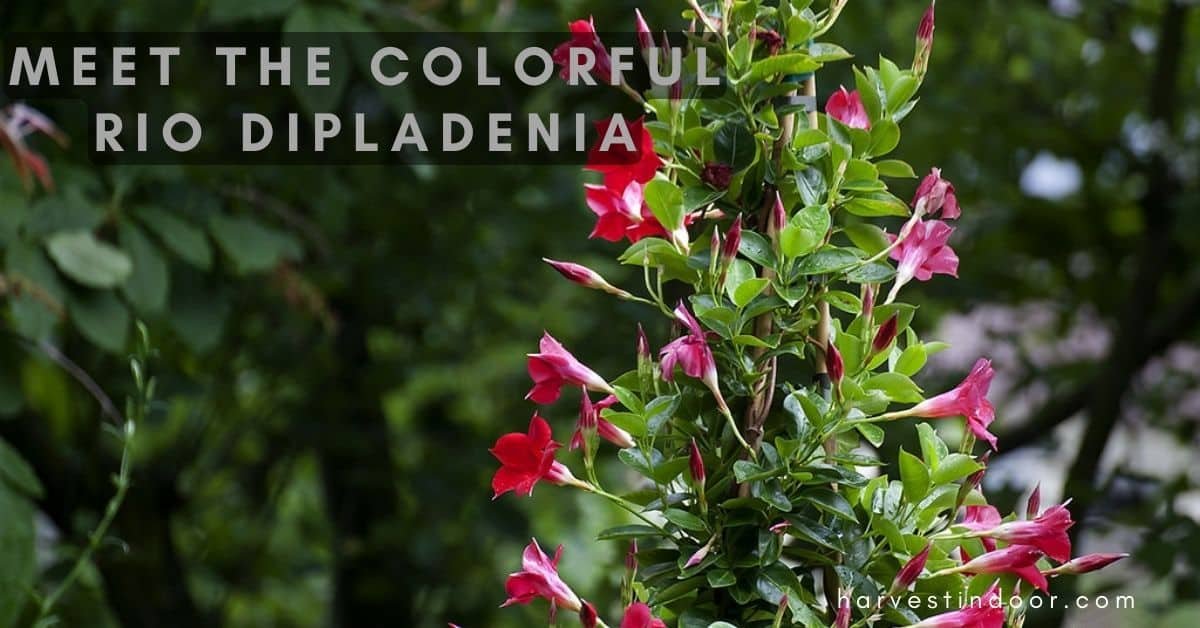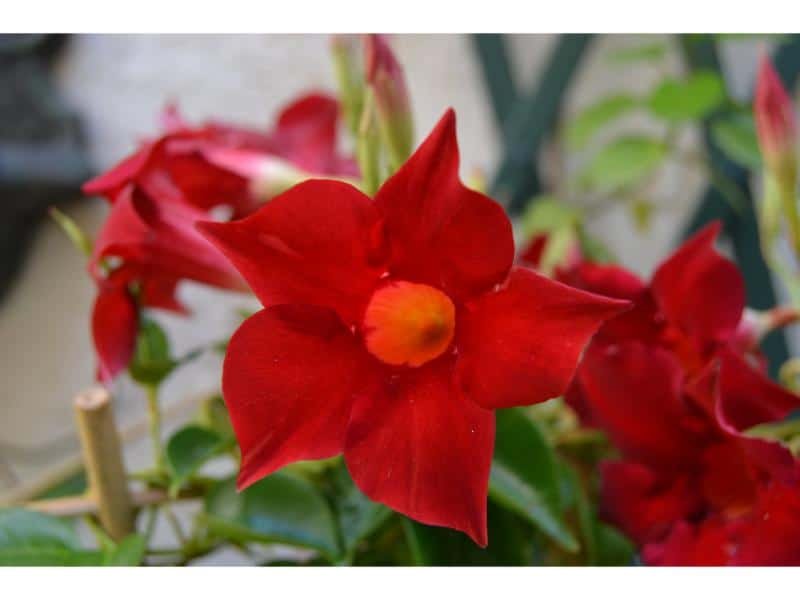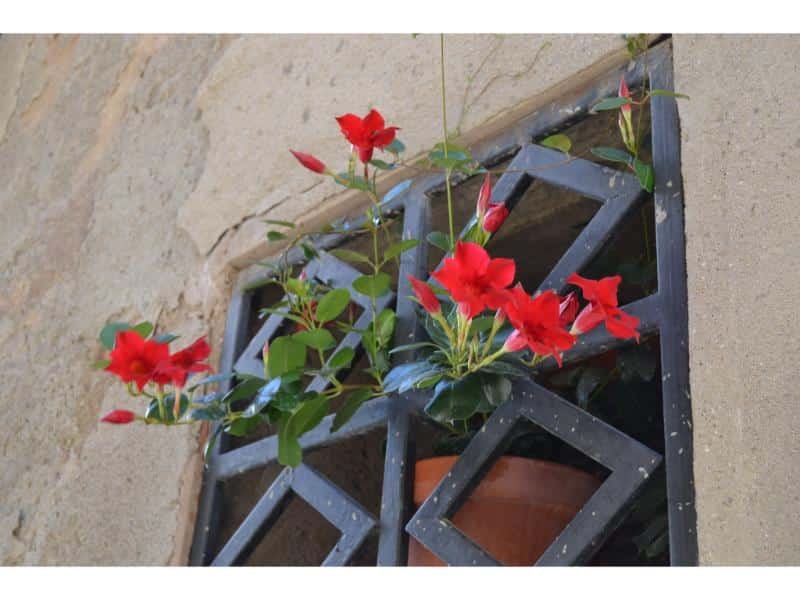Last updated on December 4th, 2023 at 06:52 am
The Rio Dipladenia is a gorgeous flowering plant known for its vibrant colors and versatility. With its lush green foliage and bright blooms, this tropical beauty can liven up any space, indoors or out. Let’s take a closer look at this stunning plant.
What is the Rio Dipladenia?
The Rio Dipladenia, scientifically known as Mandevilla sanderi, is a flowering vine in the dogbane family. It is native to the rainforests of southeastern Brazil. This fast-growing climber displays glossy, oval-shaped green leaves and an abundance of brightly colored flowers from spring until fall. The tubular flowers come in shades of pink, red, white, and yellow. They are held in clusters surrounded by brilliant yellow centers.
Table of Contents
Natural History of Dipladenia
Where does the Rio Dipladenia grow naturally?
In their native Brazilian habitat, Rio dipladenias flourish as understory plants beneath the dense rainforest canopy. Growing naturally as a vine, the supple stems twine up large tree trunks or cascade from branches in cascading sprays. The lush, shady environment of the rainforest floor provides rich, moist soil that dipladenias thrive on. Humidity is also consistently high in the dipladenia’s natural range.
What are some interesting facts about the Rio Dipladenia?
The genus Mandevilla is named for Henry John Mandeville, a 19th century British diplomat living in Buenos Aires, Argentina. Mandeville introduced the plant known as Chilean jasmine to European gardeners. The species name Mandevilla sanderi honors Henry Frederick Conrad Sander and his family, who operated well-known nurseries in St. Albans and Bruges in the 1800s. The Sanders were prominent importers and breeders who helped popularize many new plant varieties, including Mandevilla sanderi, throughout Europe.
Dipladenias are part of the milkweed family, known for their milky sap, hence “mandevilla” which originates from the French term for milk pail.
* Hummingbirds are naturally attracted to the nectar-rich flowers of dipladenias. The plants co-evolved with hummingbirds to facilitate pollination in exchange for sugary rewards!
Related article: what red flowers attract hummingbirds?
Growing Conditions for Rio Dipladenias
While native to steamy Brazilian rainforests, Rio dipladenias can also thrive as prized gardens and houseplants around the world, given proper care. Here’s how to help them flourish indoors or outside.
Where’s the best place to grow Rio Dipladenia?
Indoors: Provide medium to bright, indirect light near a south, east or west-facing window. They tolerate low light but bloom less. Low humidity can cause leaf browning, so mist frequently and use a pebble tray.
Outdoors: Plant dipladenias in bright shade in zones 10-11 or bring them outside for the summer once nights stay above 50°F. They’ll thrive on a partially shaded porch or pergola where they are protected from intense sun and wind. Morning sun and afternoon shade are ideal, allowing the vine to climb a trellis, railings, or arbor.
Does the Rio Dipladenia prefer moist or dry soil?
Moist, but not soggy. Allow the top inch or so of soil to dry out slightly between waterings but do not let the roots completely dry out. In summer, dipladenias may need water every few days. An evenly moist soil is especially important for flowering and preventing bud drop. Maintain about 40-50% relative humidity. Too dry and flowers and buds will shrivel; overly wet soil risks root rot.
Related article: what flowers like wet soil?
What’s the ideal temperature for growing Rio Dipladenia?
Daytime temperatures of 70-85°F and 60-70°F at night are ideal. They can tolerate brief temperature drops to 35°F if the soil is dry to the touch. Dipladenias struggle with temperatures exceeding 85°F and stop flowering in extreme heat, especially when humidity is low. If you live in an exceptionally hot climate, give Rio dipladenia a sheltered, shady position and mist frequently to boost humidity.
What type of soil does Rio Dipladenia prefer?
Loam or Peat: Use a well-draining, loamy mix amended with peat moss, coco coir, or bark for aeration and moisture retention. Compost can also be added. Fertilize every 2-3 weeks in the growing season using balanced liquid fertilizer diluted to half strength.
Acidic to Neutral pH: Soil pH should range from 5.5 to 7.0. Dipladenias dislike alkaline soil. Consider testing your native soil and amending it if needed to lower the pH and boost acidity. Good drainage is also crucial to prevent root rot.
Related article:
The Care and Keeping of Rio Dipladenia for Continuous Seasonal Blooms
Choosing Rio Dipladenia Varieties
With dozens of stunning dipladenia hybrids and cultivars to discover, where to begin? Let this overview guide your options.
| Variety | Description |
|---|---|
| Rio Red | Fiery clusters of tubular red blooms. The most common, beloved variety. Compact growth habit. |
| Rio Pink | Bright pink blooms with pale yellow centers. Bushy, well-branching growth is perfect for container gardens. |
| Rio White | Pure snowy white flowers are spectacular against rich green foliage. Fragrant blooms attract butterflies. |
| Rio Double Red | Fully double red blooms with ruffled petals, resembling miniature roses. Unique variety blooms spring to fall. |
There are also spot variegations with white-splashed or golden leaves and bicolored blooms in shades of red, pink, and white. Dwarf varieties under 2 feet tall are terrific for pots while vigorous climbers stretch over 10 feet tall!
| Type | Height | Description |
|---|---|---|
| Annabelle® Red | 2-3 ft | Compact with abundant clusters of wavy red blooms. Perfect for small spaces. |
| Daniella® | 8-10 ft | A vigorous climber with large pink and white bicolored blooms. Use on a tall trellis. |
Growing Rio Dipladenia as a Houseplant
With proper indoor care, Rio dipladenias make exceptional houseplants. Their lush foliage and colorful blooms can liven up any living space year-round. Follow these houseplant care tips and watch your dipladenia thrive indoors!
Light: Rio dipladenias prefer medium to bright, indirect light. An east or west-facing window is often ideal. Low light can result in sparse flowering while direct sun risks leaf scorch. Rotate plants occasionally for even growth. Use sheer curtains to filter harsh sunlight if needed.
Water: Allow the top inch of soil to dry out between waterings then soak thoroughly, taking care not to get water on leaves and stems. Reduce watering frequency in winter but never let soil completely dry out. Yellow lower leaves indicate overwatering. Bud drop or browning leaf edges indicate under-watering.
Humidity: Mist Dipladenia leaves daily or set pots on a pebble tray filled with water to increase humidity around the plant. Low humidity causes leaf browning and poor flowering. Ideal levels are 40-50% relative humidity. Consider using a humidifier in very dry environments.
Temperature: Daytime temperatures of 70-80°F are ideal. Cooler nighttime temperatures between 60-65°F can help promote bushy growth and abundant blooms. Avoid drafty areas. If the temperature drops below 50°F, flowering decreases. Over 85°F can cause heat stress.
Fertilizer: Feed every 2-3 weeks while actively growing using a balanced liquid fertilizer like 10-10-10 diluted to half strength. Reduce feeding in winter months. Excess fertilizer can burn leaf tips.
Support: Rio dipladenias grow quickly as vining plants even indoors. Use plant velcro or soft ties to gently secure climbing stems to trellises and poles. Keep soil consistently moist for healthy growth. Pinch back long vines to encourage bushiness.
Follow these care tips and your Rio dipladenia will reward you with vigorous vines and showy flowers indoors for years to come! The techniques used for growing Dipladenia houseplants successfully apply equally well when cultivating outdoor container plants on a porch or patio.
Common Problems with Rio Dipladenias
When provided with suitable growing conditions, Rio dipladenias are generally vigorous, trouble-free plants. However, they may encounter a few issues under certain circumstances.
Why are the leaves turning yellow?
Lower leaves naturally turn yellow and drop off as the plant ages. But if many leaves rapidly turn yellow it often indicates overwatering. Allow more time between waterings for the soil to dry out. Insufficient light can also cause yellow leaves as the plant cannibalizes itself to survive. Move to a brighter location.
Why are leaf edges turning brown?
Low humidity is the most common cause of tip burn and brown leaf edges. Increase humidity through misting, pebble trays, or getting a humidifier. Ensure soil moisture is adequate. Overly dry soil can worsen humidity-related scorching. Fertilizer burns from excess salts can also brown leaf tips.
Why is there a yellow sticky substance on the leaves?
Exuding sap indicates insect pests. Check closely for signs of mealybugs which look like tiny white puffs. Use a cotton swab dipped in alcohol to manually remove pests. If widespread, try insecticidal soap or neem oil sprayed on leaves. Ensure nearby plants are pest-free too.
Why are flower buds falling off?
When Dipladenia buds shrivel and drop before blooming, the likely causes are:
Over-watering or under-watering: Ensure even soil moisture
Inadequate light: Move the plant to a brighter location
Low humidity: Increase through misting and trays
Extreme temperatures: Move plant to a more moderate environment
Correcting factors like light, water, and humidity should prevent future bud drop.
- Colorful foliage houseplants to grow alongside dipladenias:
- Crotons for wildly patterned leaves
- Pink polka dot plants for vivid pink spots
- Variegated spider plants for strappy contrast
- Purple heart wandering jew for deep wine shades
- Golden pothos for bright chartreuse trails
By providing the proper growing conditions and troubleshooting problems, your gorgeous Rio Dipladenia will thrive, rewarding you with abundant colorful blooms. This cheerful plant truly captures the vibrant essence of the Brazilian rainforests it hails from. Let Rio Dipladenia bring a lively tropical flair to your indoor plant collection or outdoor garden beds.

Gardening is my passion and growing plants indoors has always been a stress relief for me. Grow a banana tree in my apartment once (although failed to produce bananas).









